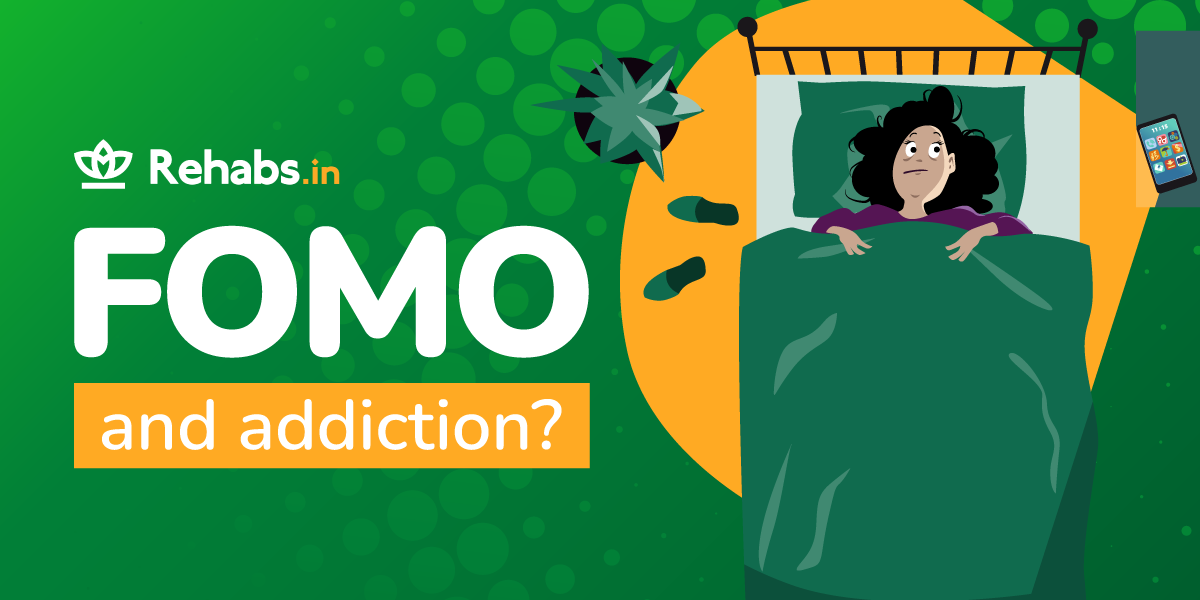The meaning of FOMO and how is it related to addiction in adolescents

In 2019, British vlogger Shannen, took part in the viral ‘spicy ramen challenge’, wherein one had to eat the notorious Samyang Hot Chicken Flavour Cup Ramen as fast as possible in front of the camera. The day after the challenge, she started passing blood in her stools and had to be hospitalized. However, even after this ordeal, she vowed to take up the challenge once again as she had not succeeded the first time.
This begs the question, what makes people do things they never would have done of their own accord? The answer lies in one of the most infamous phenomena of our times, FOMO!
What is FOMO?
‘FOMO’ is an acronym for ‘fear of missing out and was first coined and popularized by author Patrick J. McGinnis in a 2004 op-ed in The Harbus, which is a magazine published by the Harvard Business School.
While the term may be relatively new, the feeling of missing out on something has always been around. We may have experienced it as a kid when we saw our classmates going abroad for summer vacations, or when as adults we saw someone buy the latest model of car.
The current times that we are living in makes FOMO particularly worrisome. Social media coupled with high consumerism and fast trends forces people to follow, achieve, acquire or do things in the ‘immediate present, no matter whether they have the means to do it or not.
Social Media is especially popular among adolescents, as it helps them to be a part of a global community. However, keeping up with this rather huge social group or rather ‘fear of missing out is causing extremely complex social, physiological and psychological problems among adolescents. Fomo Definition & Meaning
How is it affecting mental health and social behaviour in adolescents?
To understand how social media affects adolescents more than an adult, we need to understand the stage of adolescence itself. Adolescence is a challenging phase of life between childhood and adulthood, from ages 10 to 19.
According to James E. Marcia, a renowned clinical and developmental psychologist, there are four identity statuses during the adolescent years. He distinguished them as foreclosure, identity diffusion, moratorium, and identity achievement.
Foreclosure individuals are those who have not explored their identity options and have adopted commitments laid down for them by their parents or other early authority figures. These individuals are conformist and authoritarian in nature. When it comes to social media, these individuals may become cyberbullies wherein they may have a problem with what goes against their accepted set of beliefs.
Identity diffusion individuals have not made a commitment to any set of values or beliefs or a life plan nor are they planning to do it in the near future. In the social media context, these individuals can have their self-esteem easily manipulated which can lead to stress and unhappiness.
Moratorium individuals are in the exploration process. They have relatively stable self-esteem and do not easily conform. In the social media context, they may not get easily swayed by the latest trend, however, they are still not completely prone to it and may face a crisis from time to time.
Identity achievement individuals have achieved their ideological commitments. They know who they are and what they expect from themselves and their life. In the social media context, they are not easily influenced and will not allow anything to sway them away from their life plan.
It would be a fair assumption to make that most adolescents, especially preteens are still trying to find their identity and are still in the process of character building. FOMO can lead them to make choices that may not be beneficial in the long run. It can also lead to low self-esteem, depression and addictions. Today India has the highest suicide rate in the world for youth between the 15-29 age group. While ‘FOMO’ can’t be blamed completely for this high number, it does play its part.
2230-9667 – THE ROLE OF SOCIAL MEDIA ON PERSONALITY DEVELOPMENT IN ADOLESCENCE
Suicide in India: What is the Reason Behind the Uptick
How is FOMO leading to addiction problems?
The world of social media has in many ways replaced the real world. It has set up an unreasonably high standard of expectations. The online community is full of unrealistic expectations like 20 countries to visit before you turn 20, top brands to have in your wardrobe, must have exotic breeds of dogs and cats and an endless list of viral challenges that have at times proven to be fatal.
FOMO leads to low self-esteem which left unchecked may lead to depression. It can also cause eating disorders and even addiction. Youngsters in an attempt to feel good about themselves or to forget their pain may turn to drugs. In some cases, some teenagers may take up drugs just because their friends or maybe a youth icon they idolize endorse drugs. They don’t want to miss out on being part of an inner circle. As per a study conducted by the National Commission for Protection of Child Rights, tobacco and alcohol is the most common form of substance abuse among adolescents followed by inhalants and cannabis. Drug addiction has been observed in children as young as 12 years.
FOMO may cause not just addiction to drugs, but addiction to other things as well. Youngsters may get addicted to social media sites and apps. They constantly keep checking their phones for the latest post, chat, invite, news, gossip, etc., all the while missing out on real face to face conversations with parents, friends, teachers and well-wishers. In the hyper-connected world of today, more and more youngsters are becoming isolated leading to a lack of interpersonal skills. They are also becoming addicted to shopping, gaming, gambling, following the latest trends, etc.
Fear of Missing Out (FOMO) and Teen Drug Abuse
Substance abuse: Impact on Adolescents in India – Project UDAYA | Population Council
Ways to cope with FOMO?
If you have a child or a ward under your care who is struggling with feelings of FOMO, then there are a few steps you can take.
Set a time limit: Constant checking of social media sites encourages FOMO. Set a time limit on how much time your child/ward can spend online, especially on social media sites.
Create boundaries: Inform your child/ward that you will monitor their social media accounts but also assure them of no unfair judgement on your part. This will help you to weed out profiles that may be harmful, especially those that promote drug use or delinquent behaviour.
Open communication: Encourage your child/ward to come to you if they feel that they are missing out on something or struggling to cope with the demands of life; both real and social. If they can approach you without fear then they are less likely to seek help in the wrong company.
Untiring support: If you suspect that FOMO has led your child/ward to become depressed, seek drugs, or take part in unwholesome behaviour then reach out to them. Educate yourself first on FOMO and seek the help of a counsellor for your child/ward. Get them assessed by a professional and make arrangements for treatments that may be necessary. More than anything, be a pillar of strength and support.
Even adults face feelings of FOMO and the above points are applicable even for grown-ups. FOMO can catch even the most self-assured person unawares, so always be aware of your internal thought process.
Fear of Missing Out (FOMO) and Teen Drug Abuse
In closing, it is upon us to make our children understand that not everything on social media is real. That one doesn’t have to follow popular opinions and trends and that creating one’s own identity and self-image is much cooler and will help them stand out from the herd. What’s more, you can Introduce them to the feeling of JOMO, which is the opposite of FOMO. JOMO stands for Joy of Missing Out. JOMO enables you to switch off from unnecessary distractions, teaches you to live in the moment and encourages you to enjoy your own company and that of your loved ones.
So, replace fear with joy, and a whole new world will open up for these young minds.
Sources:
Nexter.Org (2018) Crazy ‘Spicy Noodle Challenge’ Left Vlogger Bleeding from Her Bottom and Hospitalised for Four Days: “I Want to Do it Again”
https://nexter.org/crazy-spicy-noodle-challenge-vlogger-bleeding-from-her-bottom-hospitalised
Dictionary.com
https://www.dictionary.com/browse/fomo
Wankhade, V., Dadas, A. The role of social media on personality development in adolescence.
http://nevillewadia.com/wp-content/uploads/2019/03/HR6.pdf
https://en.wikipedia.org/wiki/James_Marcia
Marcia, J., (2001) Identity in Childhood and Adolescence. International Encyclopedia of the Social & Behavioural Sciences.
https://www.sciencedirect.com/topics/social-sciences/identity-status
Bordoloi, U., (2019, Oct) India Is Facing a Youth Suicide Crisis. What Do We Know and What Can We Do? Youth Ki Awaaz
https://www.youthkiawaaz.com/2019/10/india-having-the-highest-rate-of-suicide-among-youth/
Clemmensen, E., Kristina Ackermann, K., Scot Thomas, S., (2019, Nov) Is the Fear of Missing Out Assisting Teenage Drug Abuse? Projectknow.com
https://www.projectknow.com/teen/fear-of-missing-out/
Arora, M., Substance abuse: Impact on Adolescents in India. Projectudaya.in
Dodgson, L., (2018, Jul) ‘JOMO’ is the joy of missing out — here are 3 ways people find happiness in not being involved. Insider.com














